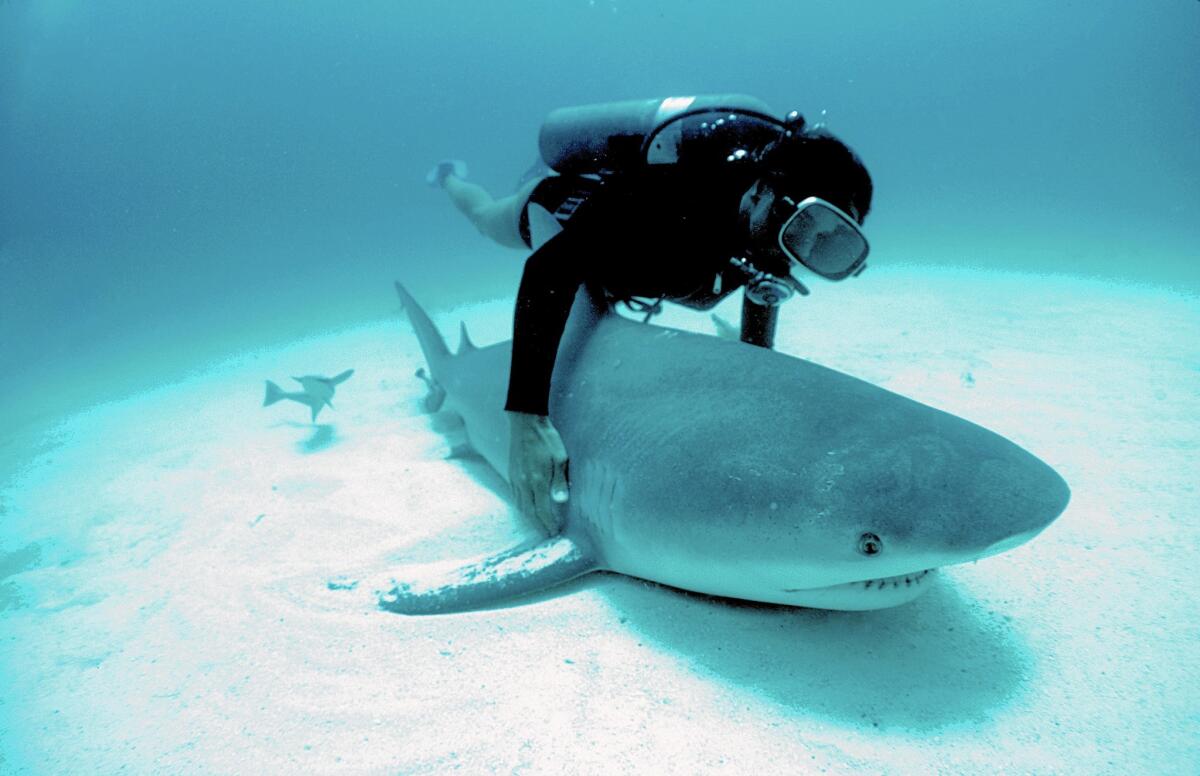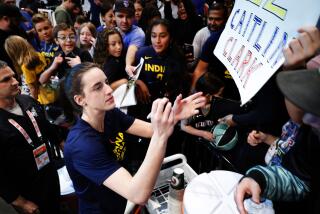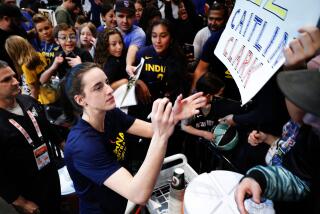Eugenie Clark dies at 92; Respected scientist swam with sharks

As a schoolgirl in the 1930s, Eugenie Clark spent countless hours pressed up to the tanks at a New York City aquarium, absorbed by the alligators, sea turtles and hundreds of species of fish just beyond the glass.
There was one creature, however, that completely enthralled her. “If only,” she thought, “I could be in the water with a shark.”
Clark eventually got her wish.
She became an intrepid underwater scientist with the nickname “Shark Lady” after she established a respected marine research laboratory in Florida in the 1950s and became a best-selling author known for her ability to explain shark behavior and other mysteries of ocean life.
Clark died Wednesday of non-smoking lung cancer at her home in Sarasota, Fla., said her son, Nikolas Konstantinou. She was 92.
Called Genie by her friends, she was the founding director of Sarasota’s Mote Marine Laboratory and Aquarium, known internationally as a center for shark research. She wrote for National Geographic, appeared on programs with Jacques Cousteau and wrote popular books, including “Lady with a Spear” (1953), about her explorations in Micronesia and the Red Sea, and “The Lady and the Sharks” (1969).
“Genie was affectionately known and respected as the ‘Shark Lady’ because her shark research was so innovative and she was dedicated to teaching the truth about sharks,” said Robert Hueter, director of the Center for Shark Research at Mote. “The studies she did in the 1950s and ‘60s were groundbreaking.”
Clark, for instance, published the first scientific study demonstrating that sharks can be trained: She taught them to release food by hitting targets with their snouts.
“People generally thought that sharks are dumb eating machines. After some study, I began to realize that these ‘gangsters’ of the deep had gotten a bad rap,” she once told historian Carolyn B. Stegman.
“Dr. Clark introduced her students, colleagues, and much of the rest of the world, to the wonder, diversity, and vulnerability of sharks,” said Sonja Fordham, a former student of Clark’s who became the founder and president of the nonprofit Shark Advocates International in Washington. “She was a role model for women, not only as a scientist but as a fearless adventurer.”
When Clark began her career in the late 1940s, marine biology was a “macho” profession, said George H. Burgess, director of the Florida Program for Shark Research at the Florida Museum of Natural History in Gainesville, who knew Clark for 40 years. “Guys were supposed to pull nets and dive. Genie jumped in with both feet, literally. She became one of the first diving biologists.”
During her seven decades in the field, she made more than 70 dives in submersibles, to depths as great as 12,000 feet. One of her last dives was on her 92nd birthday last year, in the Red Sea.
Clark was born in New York on May 4, 1922. Her mother, Yumico, was a Japanese immigrant and avid swimmer who married Charles Clark, the manager of the pool where she gave lessons. He died when their daughter was 2.
The future ichthyologist began her romance with fishes when she was about 9. Her mother worked at a Manhattan newsstand on Saturdays, and Clark talked her into letting her pass the time at the old Battery Park Aquarium.
Soon she began to collect fish. By the time she was 13 she had hundreds of tropical fish in aquariums.
At Hunter College she earned a zoology degree in 1942. She wanted to continue her studies at Columbia University but was discouraged by a professor who said she would probably end up being a housewife.
She did marry — five times — and raised four children, but without sacrificing her career. (In addition to her children, who all learned to swim before they were 2, she is survived by a grandson.)
At New York University she earned a master’s in 1946 and a doctorate in 1950. In between degrees she worked at Scripps Institution of Oceanography in La Jolla, where she learned to scuba dive from eminent fish biologist Carl Hubbs.
In 1951 she went to Egypt on a Fulbright scholarship. During 10 months in and around the Red Sea, she collected 300 species of fish, including three new species and a few dozen poisonous ones.
Her discoveries, and the novelty of her gender, earned her a write-up in the New Yorker under the headline “Fish Lady.” The next year, 1953, her autobiographical “Lady with a Spear” was published.
One of the book’s admirers was Anne Vanderbilt, a member of the wealthy Vanderbit family, who lived on the Cape Haze peninsula in southwest Florida. She invited Clark to visit and wound up building her a small laboratory there which, in 1955, became the Cape Haze Marine Laboratory, later renamed Mote after a generous donor.
She left Mote in 1966 to teach at City University of New York and later the University of Maryland. She returned to Mote as a senior scientist in 2000.
She published more than 175 articles in popular publications and scholarly journals such as Science. Her last article, on triggerfish, came out a few weeks ago.
Among her major achievements was discovering a fish called the Moses sole that produces a natural shark repellent. She also dived into caves off the coast of Mexico to examine sharks that were suspended under water—local fishermen called them “sleeping sharks”—and found that, contrary to belief, sharks did not have to be moving to breathe.
She made another important contribution when she led a group that found a pregnant whale shark off the coast of Taiwan. When they dissected it they discovered it was carrying 300 babies, a revelation for scientists who until then did not know how that species reproduced.
Clark had an “intensive, unending, wonderful curiosity about everything,” said David Doubilet, an underwater photographer who worked with her on projects for National Geographic.
One time they were in the Sea of Cortez, looking for whale sharks. When they spotted one of the huge beasts swimming by their vessel, Clark jumped in after it.
“She grabbed on a dorsal and slipped down to the base of its enormous, 15 foot high tail,” Doubilet recalled in an interview last week. “The tail went back and forth and I heard a great cry of delight. Then Genie disappeared into the blue. I thought I lost her, but she popped up a few minutes later.”
Despite many close calls, Clark was never bitten by a shark--at least not by a living one.
Years ago she was driving to a lecture with a tiger shark jaw on the seat beside her. When she braked suddenly at a red light, she reached for the specimen to keep it from falling.
The jagged teeth cut her arm, and, she told the Houston Chronicle, “I arrived at the school with my arm bleeding.”
Twitter: @ewooLATimes
More to Read
Start your day right
Sign up for Essential California for the L.A. Times biggest news, features and recommendations in your inbox six days a week.
You may occasionally receive promotional content from the Los Angeles Times.








